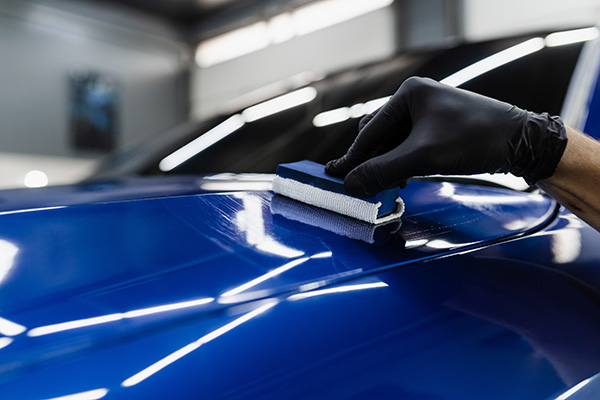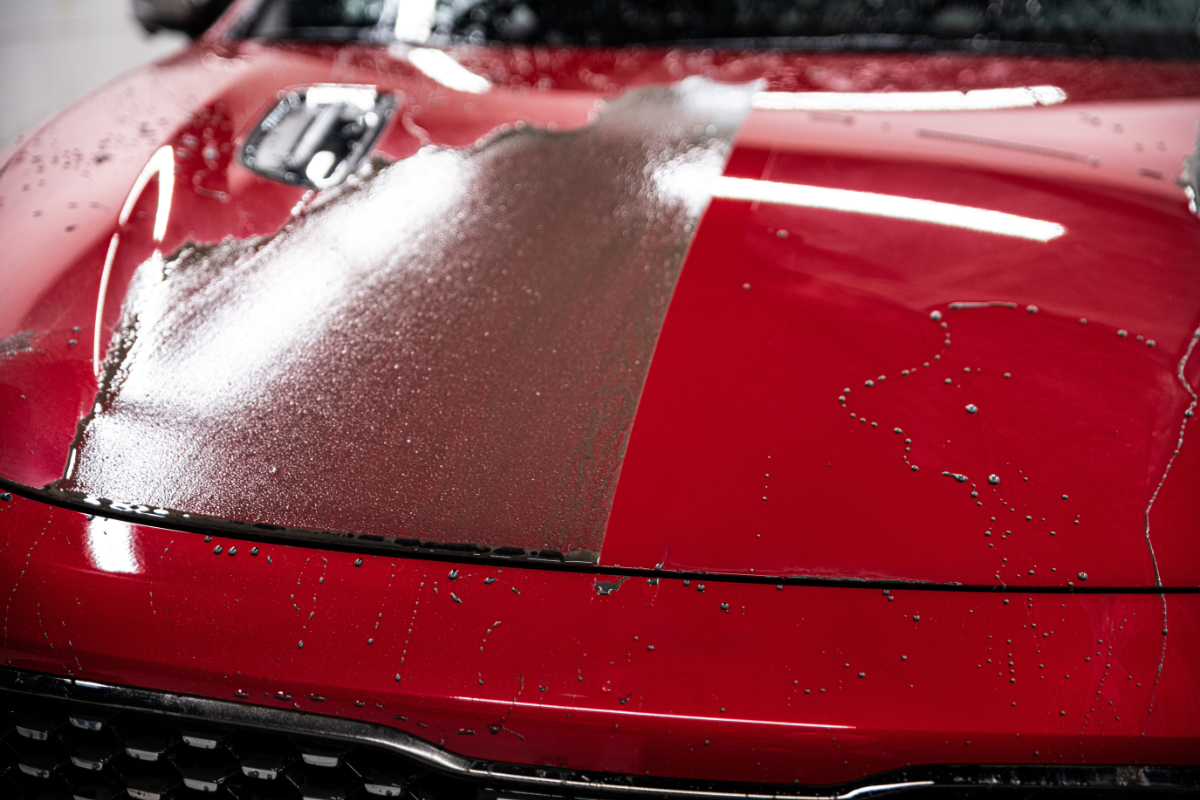The Function of Ceramic Coating in Enhancing Your Automobile's Resale Value
The Function of Ceramic Coating in Enhancing Your Automobile's Resale Value
Blog Article
The Relevance of Ceramic Coating: Shielding Your Auto's Outside With Precision
In an era where maintaining the functional and visual integrity of your automobile is critical, ceramic coating emerges as an essential service. With its one-of-a-kind bonding homes, ceramic finish supplies a degree of defense that far exceeds standard waxing approaches.
Advantages of Ceramic Coating
When it pertains to protecting an automobile's visual appeal, ceramic coating provides considerable advantages. This innovative protective layer gives a resilient guard against ecological impurities, consisting of dirt, gunk, and harmful UV rays. By creating a semi-permanent bond with the car's paint, ceramic finishings effectively stop oxidation and fading, making sure that the automobile keeps a glossy, showroom-like surface for an extensive duration. This not only enhances the lorry's aesthetic allure yet likewise contributes to its lasting worth.
In enhancement to its protective high qualities, ceramic coating supplies impressive hydrophobic properties, creating water and various other liquids to grain off effortlessly. This attribute simplifies the cleaning procedure, as dirt and debris are less most likely to follow the surface area, minimizing the regularity and initiative needed for upkeep. Additionally, the covering's resistance to chemical stains from acidic contaminants like bird droppings and tree sap is an additional noteworthy advantage, lessening prospective paint damages.
Ceramic coverings additionally enhance scrape resistance, giving a layer that can take in small abrasions and swirl marks. This attribute is specifically valuable in preserving a pristine surface area, reducing the probability of visible flaws and preserving the stability of the vehicle's paintwork in time.

How Ceramic Layer Functions
Comprehending the auto mechanics behind ceramic covering reveals its efficiency as a protective solution for lorries. Ceramic coverings are essentially fluid polymer applications that chemically bond with a car's manufacturing facility paint, developing a protective layer. This layer serves as a barrier versus ecological pollutants such as gunk, dust, and ultraviolet rays, which can degrade a car's exterior gradually. The vital part in ceramic finishing is silicon dioxide (SiO2), which stems from quartz crystals and is known for its outstanding firmness and longevity.
Application of ceramic layer includes a meticulous process. The vehicle's surface area have to be completely cleaned up and sanitized to guarantee optimal adhesion. As soon as used, the fluid polymer develops a semi-permanent bond with the paint, solidifying right into a clear, durable guard. This shield improves the car's gloss and hydrophobic buildings, promoting much easier cleaning by causing water and impurities to grain and slide off easily.
Moreover, the finishing's molecular framework offers resistance to small scrapes and chemical stains. Unlike waxes or sealants that rest on top of the paint, ceramic coverings integrate with the surface, providing resilient defense. This combination is basic to its efficiency, making certain the vehicle's finish remains immaculate for years.
Contrasting Ceramic Coating to Alternatives
In the world of vehicle protection, ceramic covering stands as an awesome option when contrasted to traditional options such as sealers and waxes. While waxes provide a momentary lustrous finish, normally lasting only a few weeks to months, ceramic coverings give a longer-lasting service, typically withstanding for several years. This toughness is attributed to the chemical bonding that happens when ceramic coatings are applied, forming a solid layer that is immune to ecological risks.
Contrastingly, sealants, although even more resilient than waxes, still disappoint the durable protection offered by ceramic layers. Sealers can normally last for as much as a year, giving a synthetic guard versus particular components. Nevertheless, they lack the superior hydrophobic buildings and UV security that ceramic coatings supply.
Furthermore, ceramic layers provide improved scrape resistance, which neither waxes neither sealants can efficiently match. In summary, while conventional waxes and sealers supply standard security, ceramic layers offer a detailed, lasting solution that substantially maintains the car and improves's exterior finish.
Application Process Explained
Using ceramic finishing to a vehicle requires a careful procedure to guarantee optimal results and sturdiness. Once cleaned, why not try here the automobile is dried out and polished to eliminate any kind of imperfections, as any type of existing scratches or swirls can come to be more noticable after the layer is applied.
Adhering to surface prep work, the application of the ceramic covering starts. The finish is generally applied in a climate-controlled setting to stop dirt particles from choosing the newly cleansed surface area. Using an applicator pad, the ceramic coating is applied in small sections to make sure also protection. It is necessary to adhere to the maker's standards regarding the suitable curing time and application density.
After application, the layer requires a certain curing duration, during which the automobile needs to be secured from water and pollutants. This treating procedure can vary depending on the product however normally varies from 24 to 48 hours. Inevitably, this comprehensive process is pivotal in achieving a shiny and resistant surface.
Maintenance Tips for Durability
To great post to read keep the longevity of a ceramic coating, adherence to a self-displined maintenance regimen is important. Normal washing is vital; make use of a pH-neutral vehicle hair shampoo and soft microfiber mitts to prevent abrasions. Stay clear of automatic cars and truck cleans, as their harsh brushes can compromise the covering's stability. Instead, opt for a hand laundry to make sure extensive yet mild cleaning.
Post-wash, drying out the lorry with a tidy microfiber towel stops water places that may break down the layer over time. In addition, apply a ceramic finishing booster every couple of months. These boosters reinforce the hydrophobic residential or commercial properties and improve the finishing's protective abilities, guaranteeing it stays effective against impurities.
Remember that vehicle parking locations play a critical function in upkeep. ceramic coating. Whenever feasible, park in shaded areas to decrease UV exposure, which can progressively weaken the coating. For lasting storage, think about utilizing a cars and truck cover for included protection versus ecological elements
Conclusion
In conclusion, ceramic covering serves as an important protective layer for automobile outsides, offering long-lasting protection versus environmental elements such as crud, dust, and uv rays. Recognizing the application process and adhering to maintenance referrals are important for making the most of the longevity and effectiveness of ceramic finish.
When it comes to preserving a car's aesthetic allure, ceramic coating offers substantial benefits. By developing a semi-permanent bond with the vehicle's paint, ceramic layers efficiently protect against oxidation and fading, making sure that redirected here the auto maintains a glossy, showroom-like finish for an extensive duration. Ceramic finishes are essentially liquid polymer applications that chemically bond with an auto's manufacturing facility paint, developing a safety layer. In summary, while conventional waxes and sealants provide basic security, ceramic layers present a comprehensive, long-lasting service that dramatically preserves the automobile and enhances's outside surface.

Report this page